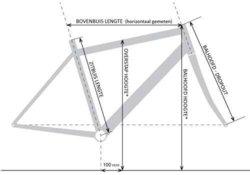If the bike doesn't work for you, then sell it on. It's no good whinging on here it won't change anything.
So far every bike I've got had problems, the last one about the worst, and these experiences brought me to fixed gear, to be able to DIY. On which basis then should I expect yet another bike to be a different story? It will be just another story, with same and new problems, and a repeat of all the work. Do you see any benefit in that? I don't.
I made the bike work for me, I found causes and solutions for the problems, and this topic is just that.
First causes have to be identified, then solutions have to be found, that's what I do and when I'm "whinging" it's to make clear exactly that, in cases this point is still not recognized.
To give another example (so blame me for "whinging"): at some point in the production stage of the bike, the dealer sent me an email that the bike was about ready, only that the chainline wasn't 100% straight but that they found a solution for that.
A year later, with the strongest and most wear reducing chain available (basically a 1/8" chain with 3/16" plates) mounted, that chains parts hung tilted nearly 45% in opposite directions. The dealer showed a baffled face and said he had never seen that before and that he had no idea how it came.
I decided to post the problem on a forum. The first answer I got was that the chainline must be quite wrong, and I was given instructions/tricks how to measure it (a direct measurement is not possible). I found the chainline as 5 mm wrong, and also that the rear hubs spokes flanges center was that amount offcenter, so that the spokes should be tensioned so that the rim/tire remained in the line of the front tire.
I mailed that forums topic to the dealer. He answered he "had followed my measurements and that they were correct", and by doing that directly contradicting his year-earlier claim that he had found a solution to achieve a 100% straight chainline.
Clearly his highest priority was selling a bike, if that bike would be what the customer wanted was lower priority and he lied to achieve the sale.
So the Nth problem now is that instability. It's not a big problem since I usually have some kilo's on top of the rack, but knowledge is where solutions start and hence my attempt here to pinpoint a precise reason for this rather serious handling difference dependent on load location.
My bike is parked outside now. Just arrive d back. If I now take off the basket with the standard luggage and the added today, and do a ride, the bike will act alike a horse that wants to throw off its rider. That MUST have a specific cause and that MUST be certain distances/ratios in the frame geometry. But which ones?
Maybe I should think "loud" here, as to give an idea of what kinda answer I'm hunting.
Imagine the rear rack was constructed so that its top would be 50 cm higher. Which effect would that have on the handling response? Or 50 cm lower?
Or some approach like this: I put 1 kg on the rack and to a test ride. Then 2 kg. Then 3 kg. And so on. To discover what weight change causes which effect on the bikes response. A precise weight could give a clue in a weight balancing problem.
My frame size is 65 cm
"ZITBUIS LENGTE" is 650 mm
"OVERSTAP HOOGTE" is 896 mm
"BOVENBUIS LENGTE" is 620 mm
"BALHOOFD HOOGTE" is 960 mm
"BALHOOFD-DROPOUT" is 662 mm.
And so on...
?


